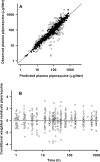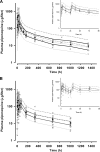Pharmacokinetic comparison of two piperaquine-containing artemisinin combination therapies in Papua New Guinean children with uncomplicated malaria
- PMID: 22470119
- PMCID: PMC3370744
- DOI: 10.1128/AAC.06232-11
Pharmacokinetic comparison of two piperaquine-containing artemisinin combination therapies in Papua New Guinean children with uncomplicated malaria
Abstract
Pharmacokinetic differences between piperaquine (PQ) base and PQ tetraphosphate were investigated in 34 Papua New Guinean children aged 5 to 10 years treated for uncomplicated malaria with artemisinin-PQ (ART-PQ) base or dihydroartemisinin-PQ (DHA-PQ) tetraphosphate. Twelve children received ART-PQ base (two daily doses of 3 mg of ART and 18 mg of PQ base as granules/kg of body weight) as recommended by the manufacturer, with regular clinical assessment and blood sampling over 56 days. PQ concentrations in plasma samples collected from 22 children of similar ages with malaria in a previously published pharmacokinetic study of DHA-PQ tetraphosphate (three daily doses of 2.5 mg of ART and 20 mg of PQ tetraphosphate as tablets/kg of body weight) were available for comparison. The disposition of ART was also assessed in the 12 children who received ART-PQ base. Plasma PQ was assayed by high-performance liquid chromatography with UV detection, and ART was assayed using liquid chromatography-mass spectrometry. Multicompartment pharmacokinetic models for PQ and ART were developed using a population-based approach. ART-PQ base was well tolerated, and initial fever abatement and parasite clearance were prompt. There were no differences between the two treatments in the values for the PQ area under the concentration-time curve from time zero to infinity (AUC(0-∞)), with medians of 49,451 (n = 12) and 44,556 (n = 22) μg · h/liter for ART-PQ base and DHA-PQ tetraphosphate, respectively. Recurrent parasitemia was associated with lower PQ exposure. Using a two-compartment ART model, the median AUC(0-∞) was 1,652 μg · h/liter. There was evidence of autoinduction of ART metabolism (relative bioavailability for the second dose, 0.27). These and previously published data suggest that a 3-day ART-PQ base regimen should be further evaluated, in line with World Health Organization recommendations for all artemisinin combination therapies.
Figures




Similar articles
-
Effect of coadministered fat on the tolerability, safety, and pharmacokinetic properties of dihydroartemisinin-piperaquine in Papua New Guinean children with uncomplicated malaria.Antimicrob Agents Chemother. 2014 Oct;58(10):5784-94. doi: 10.1128/AAC.03314-14. Epub 2014 Jul 21. Antimicrob Agents Chemother. 2014. PMID: 25049242 Free PMC article. Clinical Trial.
-
Population pharmacokinetics, tolerability, and safety of dihydroartemisinin-piperaquine and sulfadoxine-pyrimethamine-piperaquine in pregnant and nonpregnant Papua New Guinean women.Antimicrob Agents Chemother. 2015 Jul;59(7):4260-71. doi: 10.1128/AAC.00326-15. Epub 2015 May 11. Antimicrob Agents Chemother. 2015. PMID: 25963981 Free PMC article.
-
Pharmacokinetics and efficacy of piperaquine and chloroquine in Melanesian children with uncomplicated malaria.Antimicrob Agents Chemother. 2008 Jan;52(1):237-43. doi: 10.1128/AAC.00555-07. Epub 2007 Oct 29. Antimicrob Agents Chemother. 2008. PMID: 17967917 Free PMC article. Clinical Trial.
-
Paediatric formulations of artemisinin-based combination therapies for treating uncomplicated malaria in children.Cochrane Database Syst Rev. 2020 Dec 8;12(12):CD009568. doi: 10.1002/14651858.CD009568.pub2. Cochrane Database Syst Rev. 2020. PMID: 33289099 Free PMC article.
-
Efficacy and safety of dihydroartemisinin-piperaquine versus artemether-lumefantrine for treatment of uncomplicated Plasmodium falciparum malaria in Ugandan children: a systematic review and meta-analysis of randomized control trials.Malar J. 2021 Apr 1;20(1):174. doi: 10.1186/s12936-021-03711-4. Malar J. 2021. PMID: 33794897 Free PMC article.
Cited by
-
Comparison of the Pharmacokinetics and Ex Vivo Antimalarial Activities of Artesunate-Amodiaquine and Artemisinin-Piperaquine in Healthy Volunteers for Preselection Malaria Therapy.Am J Trop Med Hyg. 2018 Jul;99(1):65-72. doi: 10.4269/ajtmh.17-0434. Epub 2018 May 3. Am J Trop Med Hyg. 2018. PMID: 29741150 Free PMC article.
-
Validation and Application of a Dried Blood Spot Assay for Biofilm-Active Antibiotics Commonly Used for Treatment of Prosthetic Implant Infections.Antimicrob Agents Chemother. 2016 Jul 22;60(8):4940-55. doi: 10.1128/AAC.00756-16. Print 2016 Aug. Antimicrob Agents Chemother. 2016. PMID: 27270283 Free PMC article.
-
Age, Weight, and CYP2D6 Genotype Are Major Determinants of Primaquine Pharmacokinetics in African Children.Antimicrob Agents Chemother. 2017 Apr 24;61(5):e02590-16. doi: 10.1128/AAC.02590-16. Print 2017 May. Antimicrob Agents Chemother. 2017. PMID: 28289025 Free PMC article.
-
Randomized Noninferiority Trial of Dihydroartemisinin-Piperaquine Compared with Sulfadoxine-Pyrimethamine plus Amodiaquine for Seasonal Malaria Chemoprevention in Burkina Faso.Antimicrob Agents Chemother. 2015 Aug;59(8):4387-96. doi: 10.1128/AAC.04923-14. Epub 2015 Apr 27. Antimicrob Agents Chemother. 2015. PMID: 25918149 Free PMC article. Clinical Trial.
-
The Interactions of P-Glycoprotein with Antimalarial Drugs, Including Substrate Affinity, Inhibition and Regulation.PLoS One. 2016 Apr 5;11(4):e0152677. doi: 10.1371/journal.pone.0152677. eCollection 2016. PLoS One. 2016. PMID: 27045516 Free PMC article.
References
-
- Ahmed T, et al. 2008. Safety, tolerability, and single- and multiple-dose pharmacokinetics of piperaquine phosphate in healthy subjects. J. Clin. Pharmacol. 48:166–175 - PubMed
-
- Anderson BJ, Holford NH. 2009. Mechanistic basis of using body size and maturation to predict clearance in humans. Drug Metab. Pharmacokinet. 24:25–36 - PubMed
-
- Ashley EA, et al. 2007. How much fat is necessary to optimize lumefantrine oral bioavailability? Trop. Med. Int. Health 12:195–200 - PubMed
Publication types
MeSH terms
Substances
LinkOut - more resources
Full Text Sources
Medical

